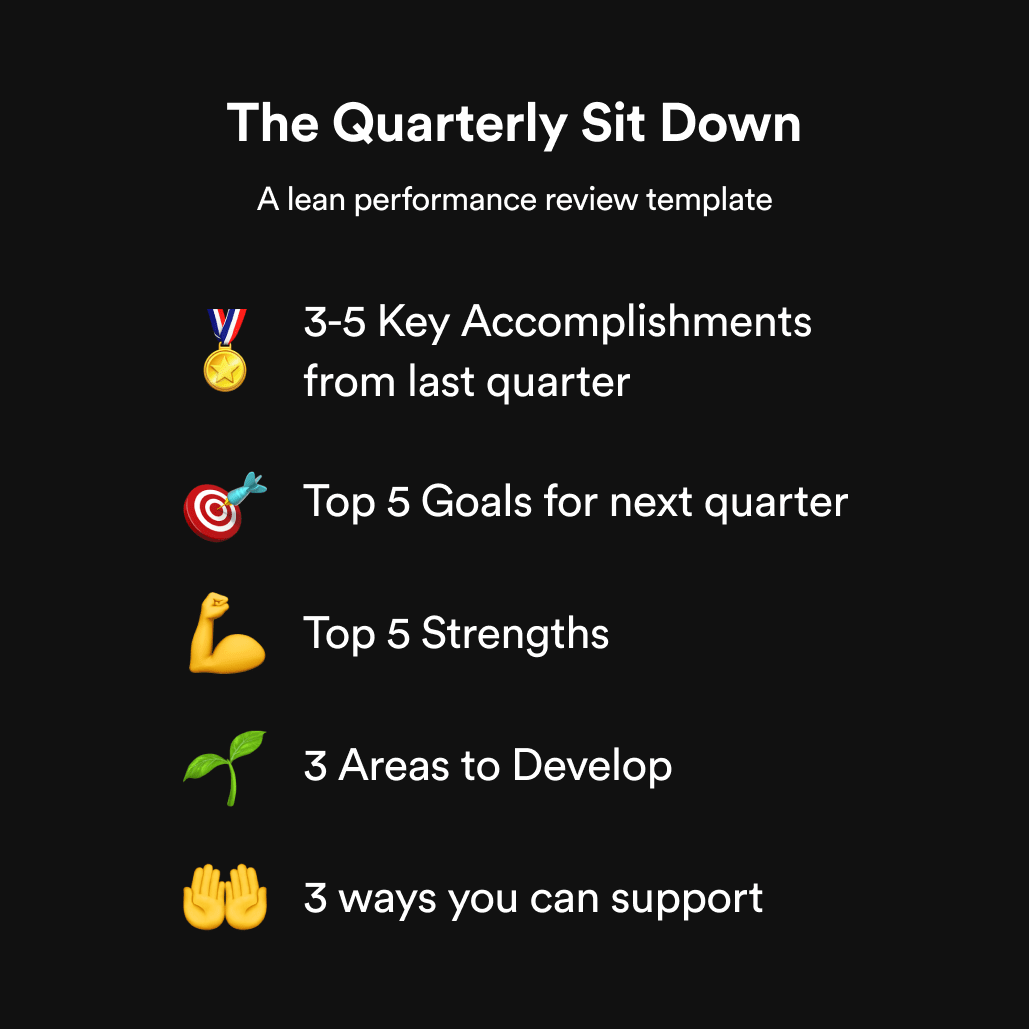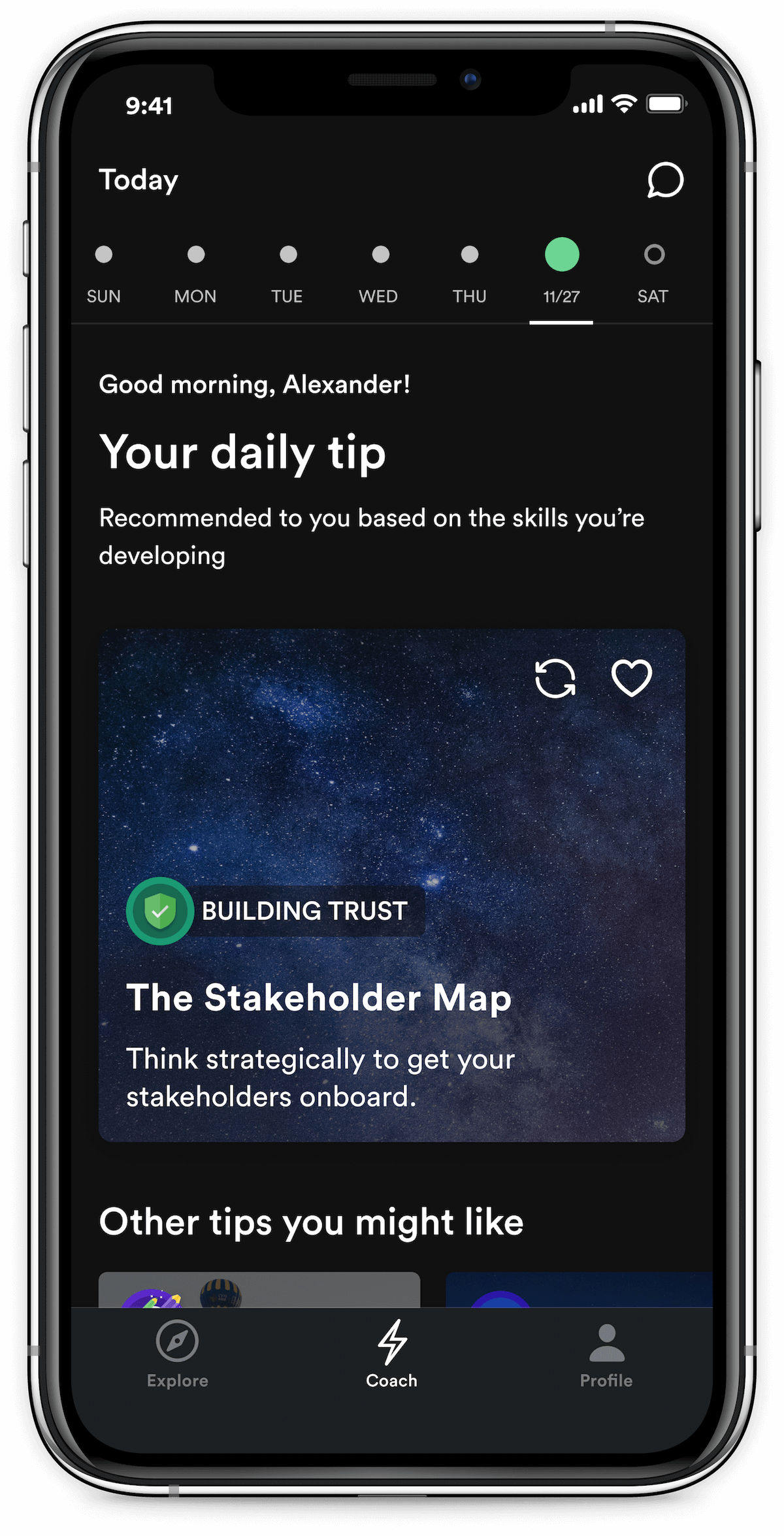Quarterly Sit Down
Build continuous performance feedback into your team with this lean framework.

Inspired by:
Jim Stoneham, CMO of Stripe

⚖️ Striking the right balance
It’s that time of year - performance review season 😨
Which of these sound more like your situation?
- You’ve got a comprehensive review process but it’s a huge drain on the team or;
- Your process is too lightweight and irregular to create any meaningful change
How can you create a performance review that strikes the right balance? Jim Stoneham, CMO of Stripe, has a framework that’s manageable, comprehensive and provocative! 🙏
Let's take a look!
The Quarterly Sit-Down
It’s a meeting that happens every quarter, but instead of a formal performance discussion, it’s an approachable conversation.
Ahead of the session, you and your report will fill these 5 elements, to guide the discussion during your sit down:
- 3-5 Key accomplishments last quarter
- Top 5 goals for next quarter
- Top 5 strengths
- 3 areas to develop
- 3 ways you can support them
🏅 3-5 Key Accomplishments
Let’s say you’re sharing accomplishments with your junior engineer. You might say they:
- Shipped 3 new features and;
- Increased product performance by 20%
Don’t forget to include collaborative achievements too:
- Developed a strong relationship with the new engineer
- Set up a more streamlined handover process with the design team
For best results, tie it back to the team’s larger targets. This will help you build a case for increased salary or promotions.
🎯 Top 5 Goals for next quarter
Consider what’s coming up next for the business quarter, and give your report that context.
Maybe you’re planning to focus on growing the customer base, so you want to focus them on building infrastructure to support that:
- Create more automated tests
- Move to a more robust database
Remember the behavioral stuff too
- Develop support skills so that you can fix issues independently
- Learn to facilitate team meetings
💪 Top 5 Strengths
Studies have shown that focusing on strengths accelerates growth as it builds confidence to learn new things and take on challenges.
Observe your team member 3-4 weeks before and ask yourself:
• What value do they add when they're present? • In which domain are they the most helpful resource? • What metrics or situations improve with their contribution?
You can also ask those who work most closely with your report these same questions.
🌱 3 Areas to Develop
Remembering the team’s larger goals and context, ask yourself:
• What do they typically struggle with? • What gaps in the team could they move into? • Where do you see untapped potential?
Again, you might want to ask their teammates to give a more rounded perspective.
Note: • For honest and critical feedback, consider making it anonymous • If you prioritize transparency and want to discuss the feedback together, consider keeping it open.
It depends on your culture and the tradeoffs you’re comfortable making.
🤲 3 Ways to Support
Now you’ve got the goals, strengths and opportunities written down, it’s time to think about how you can support their growth.
Ask yourself: • Is there a promotion, pay rise, or more responsibility you can help them attain? • Do they need specific coaching either internally or externally? • What projects or tasks can you give them to speed up their learning?
👯 Co-create the next quarter
Once you’ve gathered all the information, it’s time to sit down together!
Give yourself an hour, maybe two – especially if there’s lots to discuss.
And remember a performance review is... • Just a collection of data and opinions, it can have gaps and flaws like any other feedback. • A dialogue: listen to their perspective as much as giving your own. • A partnership: Growth and action should happen on both sides!

Become a world-class leader in two minutes a day